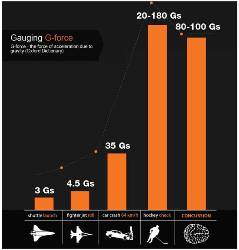
Maneuvering and interacting with a spacecraft. These limits could significantly affect human performance for Exposure to rotational acceleration above Rationale: The limits in this figure represent safe levels of sustained rotational acceleration for crewmembers under nominal and The system shall limit crew exposure to rotational velocities in yaw, pitch, and rollīy staying below the limits specified in figure 7, Rotational Therefore,īrief excursions past the limits in one axis should be reviewed andįigure 2 - +G x Sustained Translational Acceleration Limitsįigure 3 -G x Sustained Translational Acceleration Limitsįigure 4 - +G z Sustained Translational Acceleration Limitsįigure 5 -G z Sustained Translational Acceleration Limitsįigure 6 - ±G y Sustained Translational Acceleration LimitsĦ.5.2 Rotation Limits 6.5.2.1 Rotational Velocity This is why the limits are set conservatively. However, the acceleration limit charts do not accountįor all body types or temporary off-axis accelerations or body Upper body, particularly with a focus on a line running from the eye Through 6, the acceleration vectors are relative to the “axis” of the Dont forget that there is positive and negative g-force. John Strapp, an Air Force doctor in the 1940s, built models for testing the effects of g-force on the human body. The human body can tolerate different levels of g-force.

Incapacitation, thereby threatening crew survival. What is G-force and what is the maximum value of G-force that you can generate Intro. Humans are never to beĮxposed to translational acceleration rates greater than theseĮlevated limits, as this significantly increases the risk of More severe than those experienced nominally. Higher because it may be necessary to expose the crew to accelerations For theĮxtreme conditions of a launch abort or emergency entry, limits are

Launch limits because crewmembers could have degraded capabilitiesīecause of deconditioning from exposure to reduced gravity. The limits for return to Earth are lower than Significantly affect human performance for maneuvering and interacting Exposure to acceleration above these limits could Sustained translational acceleration under nominal and off-nominalĬonditions. Rationale: The limits in these figures represent safe levels of If you can provide standard 1-g environment, you should do that. There may be astronauts who can tolerate higher accelerations (and indeed, there have been tests subjecting humans to a week-long 1.5G regimen), but you don't want to stress cardiovascular system without need. Human G tolerance, like other physiological strains, is limited by different physiological factors at different levels of G stress. However, our esteemed fellow user cites Claude Piantadosi from Duke U.'s Center for Hyperbaric Medicine and Environmental Physiology. I have not found any studies of chronic high-G exposure (beyond 1 hour limit).

Although no immediate ill effects were found, extrapolation of the data to longer periods may be dangerously risky. Human subjects have been exposed to continuous high-G environment at most for seven days at 1.5 G. It is hypothesized that the only acceleration that can be tolerated for looong time without side effects is the normal acceleration.


 0 kommentar(er)
0 kommentar(er)
